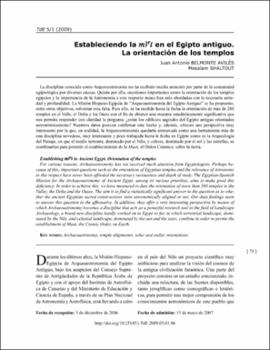Estableciendo la Maat en el Egipto antiguo. La orientación de los templos
Date
2009Abstract
La disciplina conocida como Arqueoastronomía no ha recibido mucha atención por parte de la comunidad
egiptológica por diversas causas. Quizás por ello, cuestiones importantes como la orientación de los templos
egipcios y la importancia de la Astronomía a este respecto nunca han sido abordadas con la necesaria seriedad
y profundidad. La Misión Hispano-Egipcia de “Arqueoastronomía del Egipto Antiguo” se ha propuesto,
entre otros objetivos, solventar esta falta. Para ello, se ha medido hasta la fecha la orientación de más de 280
templos en el Valle, el Delta y los Oasis con el fin de obtener una muestra estadísticamente significativa que
nos permita responder con claridad la pregunta: ¿están los edificios sagrados del Egipto antiguo orientados
astronómicamente? Nuestros datos parecen confirmar este hecho y, además, ofrecen una perspectiva muy
interesante por la que, en realidad, la Arqueoastronomía quedaría enmarcada como una herramienta más de
una disciplina novedosa, muy interesante y poco trabajada hasta le fecha en Egipto como es la Arqueología
del Paisaje, en que el medio terrestre, dominado por el Nilo, y celeste, dominado por el sol y las estrellas, se
combinarían para permitir el establecimiento de la Maat, el Orden Cósmico, sobre la tierra. For various reasons, Archaeoastronomy has not received much attention from Egyptologists. Perhaps because
of this, important questions such as the orientation of Egyptian temples and the relevance of Astronomy
in this respect have never been afforded the necessary seriousness and depth of study. The Egyptian-Spanish
Mission for the Archaeoastronomy of Ancient Egypt, among its various priorities, aims to make good this
deficiency. In order to achieve this, we have measured to date the orientation of more than 280 temples in the
Valley, the Delta and the Oases. The aim is to find a statistically significant answer to the question as to whether
the ancient Egyptian sacred constructions were astronomically aligned or not. Our data findings seem
to answer this question in the affirmative. In addition, they offer a very interesting perspective by means of
which Archaeoastronomy becomes a discipline that acts as a powerful research tool in the field of Landscape
Archaeology, a brand new discipline hardly worked on in Egypt so far, in which terrestrial landscape, dominated
by the Nile, and celestial landscape, dominated by the sun and the stars, combine in order to permit the
establishment of Maat, the Cosmic Order, on Earth.





